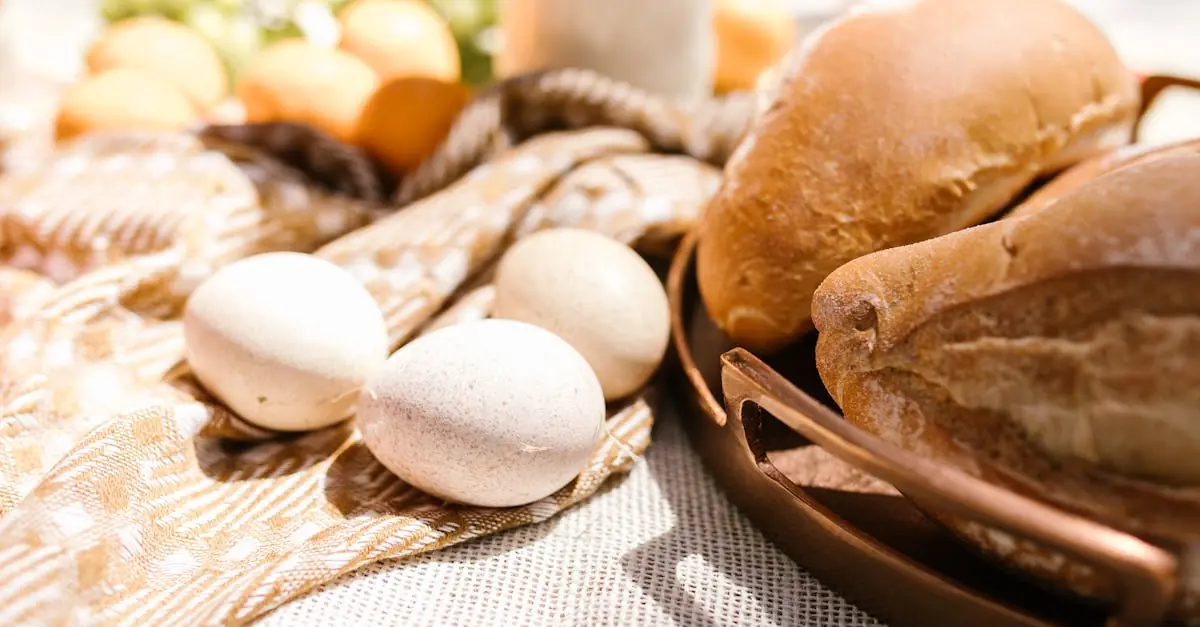Imagine whipping up a gourmet meal under the sun while your friends sip drinks and soak up the atmosphere. An outdoor kitchen can transform any backyard into the ultimate entertaining space, and the secret to its success often lies in the cabinets. DIY outdoor kitchen cabinets not only save money but also let creativity run wild.
Table of Contents
ToggleOverview of Outdoor Kitchen Cabinets DIY
Outdoor kitchen cabinets serve as essential components that maximize storage and organization. A variety of materials are suitable for these cabinets, such as weather-resistant wood, stainless steel, or weatherproof composites. Each type offers durability and aesthetic appeal, lending character to the outdoor space.
DIY projects allow homeowners to customize their cabinets according to specific needs and preferences. Designing the cabinets to match the overall style of the home introduces a cohesive look. Popular styles range from rustic to modern, with countless options available for finishes and hardware.
Building outdoor kitchen cabinets requires careful planning and measurement. It’s crucial to draft a design that incorporates both functionality and accessibility. For example, cabinets can include pull-out drawers for easy access to grilling tools or spices.
Budget considerations impact the choice of materials and tools. While high-quality materials might incur higher upfront costs, their longevity often justifies the investment. Savings from DIY projects can be redirected toward premium finishes or additional features.
Assembly techniques vary depending on the chosen design. Common methods include using screws, brackets, or waterproof adhesives. Selecting suitable construction methods enhances the cabinets’ strength, ensuring they withstand outdoor elements.
Ultimately, DIY outdoor kitchen cabinets provide an opportunity to create a unique cooking space that reflects personal style. The satisfaction of building custom cabinets adds to the enjoyment of using the outdoor kitchen for entertaining and cooking.
Planning Your Outdoor Kitchen Cabinets
Planning outdoor kitchen cabinets requires careful consideration of space and functionality. Homeowners must ensure the design complements the overall aesthetic of the outdoor area.
Measuring Your Space
Measuring the kitchen area involves determining available space for cabinets. Utilize a tape measure to gather precise dimensions including width, height, and depth. When planning, consider existing outdoor appliances and fixtures for a cohesive look. Assessing spacing allows for optimal cabinet placement and prevents overcrowding. Understanding the dimensions helps avoid potential mistakes during the construction phase.
Selecting Materials
Selecting materials greatly impacts the durability and appearance of outdoor kitchen cabinets. Weather-resistant wood options like teak or cedar resist moisture and insects. Stainless steel offers a sleek, modern look with excellent resilience against weather conditions. Weatherproof composites combine aesthetic appeal and functionality, providing various design choices. Each material type should align with the overall theme while ensuring long-term durability. Prioritizing high-quality materials may increase initial costs but often leads to greater longevity and lower maintenance.
Building Your Outdoor Kitchen Cabinets
Creating outdoor kitchen cabinets involves careful planning and creativity. A productive approach guarantees a functional and stylish addition to any outdoor space.
Essential Tools and Supplies
Gathering the right tools and supplies is crucial. Essential tools include a tape measure, circular saw, and drill. Plywood and weather-resistant wood serve as primary materials. Stainless steel hinges and weatherproof sealant enhance durability. Proper screws and a level ensure stability and functionality. Additionally, clamps can help hold pieces together during assembly. Consider safety gear such as goggles and gloves as part of the necessary supplies. Having everything ready streamlines the building process, facilitating a more efficient setup.
Step-by-Step Construction Guide
Constructing outdoor kitchen cabinets involves several clear steps. Start by measuring and marking dimensions on the plywood. Cut the panels according to marked sizes using a circular saw. Assemble the frame by securing the sides to the top and bottom using screws. Next, attach the back panel for added stability. Install shelves or drawers according to design preferences, ensuring they fit smoothly. After assembly, sand all surfaces to prevent splinters. Finally, finish with outdoor paint or sealant for protection against the elements. Following these steps allows for a durable and personalized outdoor kitchen experience.
Finishing Touches for Outdoor Kitchen Cabinets
Finishing touches elevate outdoor kitchen cabinets, ensuring durability and style. Attention to detail makes a significant difference in longevity and function.
Weatherproofing and Sealing
Weatherproofing enhances the lifespan of outdoor kitchen cabinets. Applying a high-quality sealant protects against moisture, UV rays, and temperature fluctuations. Choose a sealant specifically designed for outdoor use for optimal performance. Regular maintenance, such as reapplying sealant every few years, ensures continued protection. Additionally, consider using a water-resistant finish to enhance aesthetics while safeguarding surfaces. This adds an extra layer of defense against rain and spills, maintaining the cabinets’ structural integrity.
Choosing the Right Hardware
Selecting the right hardware complements the outdoor kitchen’s overall design. Stainless steel handles and hinges resist rust and corrosion, making them suitable for outdoor environments. Opt for weather-resistant materials that remain functional under exposure to the elements. Soft-close hinges provide a gentle, quiet closure, ensuring durability while adding convenience. Choosing finishes like brushed nickel or matte black can enhance visual appeal, aligning with personal style preferences. Ultimately, hardware choices should reflect both functionality and the rich aesthetic of the outdoor space.
Maintenance Tips for Outdoor Kitchen Cabinets
Regular maintenance ensures outdoor kitchen cabinets remain functional and visually appealing. Start by cleaning cabinets with mild soap and water to remove dirt and grime. Ensure that all surfaces are dried thoroughly to prevent moisture buildup.
Inspect weather-resistant wood and composite materials for signs of wear. Small scratches or blemishes may require sanding and refinishing. Apply a weatherproof sealant each year to maintain protection against the elements.
Monitor stainless steel surfaces for fingerprints and smudges. Utilize a stainless steel cleaner specifically designed to enhance shine and remove stains. Avoid abrasive materials that could scratch the surface.
Pay attention to hardware, including hinges and handles. Regularly check for rust or corrosion and replace any damaged components promptly. Using stainless steel hardware can extend lifespan since it resists rust.
Additionally, consider the environment around the outdoor kitchen. Plants and landscaping may require trimming to avoid contact with cabinets, preventing damage. If the area experiences harsh weather conditions, installing protective coverings during the off-season helps preserve cabinet integrity.
Finally, conduct a seasonal deep clean. Remove any items stored inside cabinets for thorough inspection and cleaning. Evaluate the overall condition and functionality, making adjustments if necessary to maintain optimal performance.
Creating DIY outdoor kitchen cabinets not only enhances the functionality of a backyard but also allows homeowners to express their personal style. With careful planning and the right materials, it’s possible to build durable and attractive cabinets that withstand the elements. Regular maintenance ensures these cabinets remain in top condition, making outdoor cooking and entertaining a joy for years to come. By investing time and effort into this project, anyone can transform their outdoor space into a culinary paradise that complements their lifestyle.




